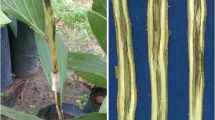Abstract
TenTrichoderma isolates were studied under greenhouse conditions as potential agents for biocontrol of yam leaf spot, caused byCurvularia eragrostidis. TheTrichoderma isolates demonstrated high efficiency of disease control. Application of the antagonists on the same day asC. eragrostidis inoculation showed the best results. One isolate achieved 75 percent disease severity reduction. The survival of theTrichoderma isolates decreased after its application on the phylloplane with values of 57 and 41 percent at the 49th day, in the absence and presence of the phytopathogen respectively. The antagonism persisted well againstC. eragrostidis, the TN1 isolate praises 89 percent.
Similar content being viewed by others
References
Ramos JEL, Moura RMM. Novas informações sobre o controle químico da queima das folhas do inhame (Dioscorea cayennensis Lam.) Cad Omega Univ Fed Rural PE 1992; 4: 197–206.
Emater-IPA. Sistema de produção para cará da costa: Agreste Setentrional, Agreste Meridional e Mata Norte. Recife: Emater, 1985 (Série sistema de produção; boletim, 11.)
Blakeman JP, Brown AS, Mercer PC. Biological control of plant disease — Present and future trends. Pesq Agropec Bras 1992; 27: 151–164.
Henis Y, Adams PB, Lewis JA, Papavizas GC. Penetration of sclerotia ofSclerotium rolfsii byTrichoderma spp. Phytopathology 1983; 73: 1043–1046.
Dubos B, Bulit J. Filamentous fungi and biocontrol agents on aerial plant surfaces. In: Blakeman J (ed), Microbial ecology of the phylloplane. London: Academic Press, 1981: 353–367.
Papavizas GC.Trichoderma andGliocladium: biology, ecology, and potential for biocontrol. Ann Rev Phytopath 1985; 23: 23–54.
Dubos B. Fungal antagonism in aerial agrobiocinoses. In: Chet I (ed), Innovative approaches to plant disease control. New York: John Wiley and Sons, 1987: 107–135.
Melo I. Potencialidades da utilização deTrichoderma spp. no controle biológico de doenças de plantas. In: Bettiol W (ed), Controle biológico de doenças de plantas. Jaguariúna: Embrapa-CNPDA, 1991: 135–156.
Rai B, Singh DB. Antagonistic activity of some leaf surface microfungi againstAlternaria brassicae andDrechslera graminea. Trans Br Mycol Soc 1980; 75: 363–369.
Dubos B, Jailloux F, Bulit J. Protection du vignole contre la porriture grises: Les proprietés antagonistes deTrichoderma à l'egard duBotrytis cinerea. Coll l'INRA 1982; 18: 205–219.
Nelson ME, Powelson ML. Biological control of grey mold of snap beans byTrichoderma hamatum. Plant Dis 1988; 72: 727–729.
Gullino ML, Garibaldi A. Attempts of biological control of grey mould of strawberry in plastic houses. In: Cavalloro R, Pelerents C (eds), Integrated pest management in protected vegetable crops. Rotterdam: A.A. Balkema, 1989: 245–249.
Mercier J, Reeleder RD. Interactions betweenSclerotinia sclerotiorum and other fungi on the phylloplane of lettuce. Can J Bot 1987; 65: 1633–1637.
Chet I.Trichoderma — Application, mode of action, and potential as a biocontrol agent of soilborne plant pathogens. In: Chet I (ed), Innovative approaches to plant disease control. New York: John Wiley & Sons, 1987: 137–160.
Fokkema NJ. Fungal leaf saprophytes, beneficial or detrimental? In: Blakeman JP (ed), Microbial ecology of the phylloplane. London: Academic Press, 1981: 433–454.
Nelson EB. Current limits to biological control of fungal phytopathogens. In: Arora DK, Rai B, Mukerji KG, Knudsen G, (eds), Handbook of applied mycology: Soil and plants. New York: Marcel Dekker, 1991: 327–355.
McKenzie LI, Benzi D, Dellavalle D. Survival on the phylloplane of strains ofTrichoderma spp. antagonistics toBotrytis cinerea. Petria 1991; 1: 133–134.
Vitti AJ, Ghini R. Sobrevivēnica de linhagens deTrichoderma resistentes a iprodione em morangueiro. Sum Phytopath 1990; 16: 36.
Zadoks JC, Schein RD. Epidemiology and plant disease management. New York/London: Oxford University Press, 1979.
Elad Y. Reasons for the delay in development of biological control of foliar pathogens. Phytoparasitica 1990; 18: 99–105.
Author information
Authors and Affiliations
Rights and permissions
About this article
Cite this article
Michereff, S.J., da Silveira, N.S.S., Reis, A. et al. Greenhouse screening ofTrichoderma isolates for control ofCurvularia leaf spot of yam. Mycopathologia 130, 103–108 (1995). https://doi.org/10.1007/BF01103458
Received:
Accepted:
Issue Date:
DOI: https://doi.org/10.1007/BF01103458




